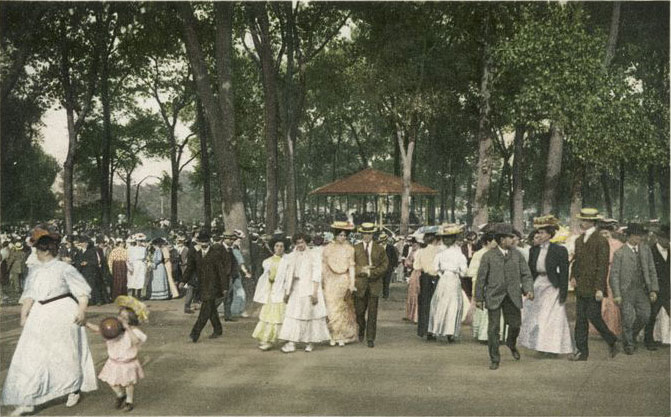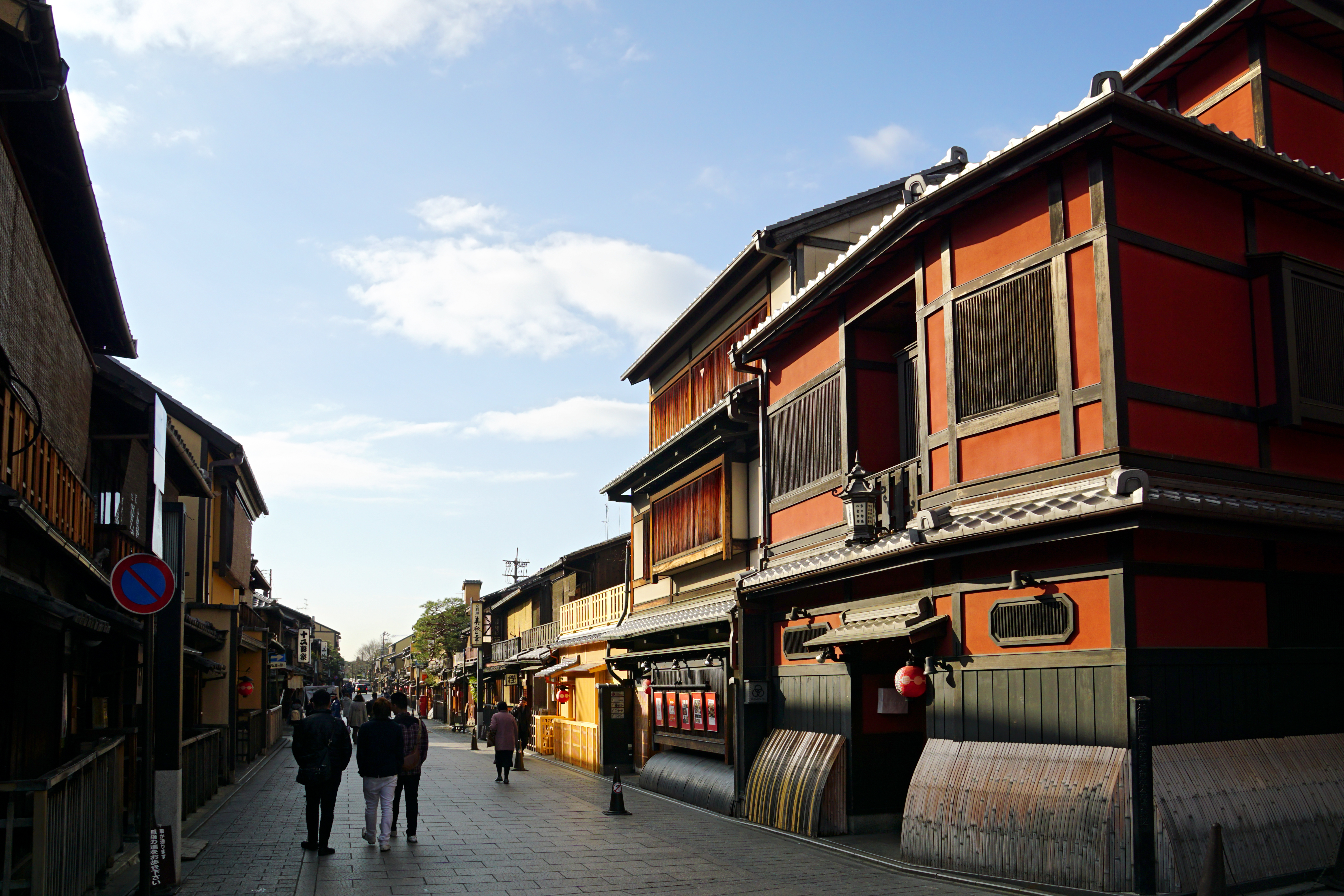|
Maruyama Park
is a park in Kyoto, Japan. It is noted as the main center for cherry blossom viewing in Kyoto, and can get extremely crowded at that time of year (April). The park's star attraction is a weeping cherry tree (''shidarezakura'') which becomes lit up at night. It also becomes busy in the New Year's Eve Festivals. The main entrance to the park is through Yasaka Shrine, which sits at the eastern end of Shijō Street runs in the center of Kyoto, Japan from east to west through the commercial center of the city. Shijō literally means ''Fourth Avenue'' of Heian-kyō, the ancient capital. History The section between Shinkyōgoku street and the vicini ... in the Gion District. Directly to the north (and abutting the park) is the vast temple of Chion-in, followed by the smaller temple of Shōren-in. The park is a nationally designated Place of Scenic Beauty. References External links Information about Maruyama parkMap Places of Scenic Beauty Parks in Japan ... [...More Info...] [...Related Items...] OR: [Wikipedia] [Google] [Baidu] |
Urban Park
An urban park or metropolitan park, also known as a city park, municipal park (North America), public park, public open space, or municipal gardens (United Kingdom, UK), is a park or botanical garden in cities, densely populated suburbia and other municipal corporation, incorporated places that offers open space reserve, green space and places for recreation to residents and visitors. Urban parks are generally Landscape architecture, landscaped by design, instead of lands left in their natural state. The design, operation and maintenance, repair and operations, maintenance is usually done by government agencies, typically on the local government, local level, but may occasionally be contracted out to a park conservancy, "friends of" group, or private sector company. Depending on size, budget, and land features, which varies considerably among individual parks, common features include playgrounds, gardens, hiking, running, fitness trails or paths, bridle paths, sports fields and c ... [...More Info...] [...Related Items...] OR: [Wikipedia] [Google] [Baidu] |
Cultural Properties Of Japan
A is administered by the Government of Japan, Japanese government's Agency for Cultural Affairs (Ministry of Education, Culture, Sports, Science and Technology), and includes Tangible Cultural Properties of Japan, tangible properties (structures and works of art or craft); Intangible Cultural Properties of Japan, intangible properties (performing arts and craft techniques); Mingei, folk properties both tangible and intangible; Monuments of Japan, monuments historic, scenic and natural; Cultural Landscapes of Japan, cultural landscapes; and Groups of Traditional Buildings, groups of traditional buildings. Cultural Properties of Japan#Buried Cultural Properties, Buried properties and Conservation Techniques for Cultural Properties, conservation techniques are also protected. Together these cultural properties are to be preserved and utilized as the heritage of the Japanese people. Not all Cultural Properties of Japan were created in Japan; some are from China, Korea or other countri ... [...More Info...] [...Related Items...] OR: [Wikipedia] [Google] [Baidu] |
Parks And Gardens In Kyoto Prefecture
A park is an area of natural, semi-natural or planted space set aside for human enjoyment and recreation or for the protection of wildlife or natural habitats. Urban parks are urban green space, green spaces set aside for recreation inside towns and cities. National parks and country parks are green spaces used for recreation in the countryside. State parks and provincial parks are administered by sub-national government states and agencies. Parks may consist of grassy areas, rocks, soil and trees, but may also contain buildings and other artifacts such as monuments, fountains or playground structures. Many parks have fields for playing sports such as baseball and football, and paved areas for games such as basketball. Many parks have trails for walking, biking and other activities. Some parks are built adjacent to bodies of water or watercourses and may comprise a beach or boat dock area. Urban parks often have benches for sitting and may contain picnic tables and barbecue gr ... [...More Info...] [...Related Items...] OR: [Wikipedia] [Google] [Baidu] |
Places Of Scenic Beauty
is a collective term used by the Japanese government's Law for the Protection of Cultural Properties to denote Cultural Properties of JapanIn this article, capitals indicate an official designation as opposed to a simple definition, e.g "Cultural Properties" as opposed to "cultural properties". as historic locations such as Midden, shell mounds, kofun, ancient tombs, sites of palaces, sites of Japanese castles, forts or castles, monumental dwelling houses and other sites of high historical or scientific value; gardens, bridges, gorges, mountains, and other places of great scenic beauty; and natural features such as animals, plants, and geological or mineral formations of high scientific value. Designated monuments of Japan The government ''designates'' (as opposed to ''Registered Monuments of Japan, registers'') "significant" items of this kind as Cultural Properties (文化財 ''bunkazai'') and classifies them in one of three categories: * * , * . Items of particularly high sig ... [...More Info...] [...Related Items...] OR: [Wikipedia] [Google] [Baidu] |
Prefecture Navobox
A prefecture (from the Latin word, "''praefectura"'') is an administrative jurisdiction traditionally governed by an appointed prefect. This can be a regional or local government subdivision in various countries, or a subdivision in certain international church structures. During the antiquity, it was the name of a type of Roman district. In the 21st century, the term prefecture is used for the modern first-level subdivisions of the Central African Republic, Japan, and Morocco. Literal prefectures Antiquity ''Prefecture'' originally referred to several distinct administrative structures in ancient Rome. In the Roman Republic and early Empire, a praefectura was a town or community lacking full civic autonomy and administered by a Roman-appointed Praefectus. These praefecturae were common in Italy before the extension of Roman citizenship and typically occupied a lower legal status than a municipium or colonia. Later, during the Tetrarchy, Emperor Diocletian reorganized the Roma ... [...More Info...] [...Related Items...] OR: [Wikipedia] [Google] [Baidu] |
Agency For Cultural Affairs
The is a special body of the Japanese Ministry of Education, Culture, Sports, Science and Technology (MEXT). It was set up in 1968 to promote Japanese arts and culture. The agency's budget for FY 2018 rose to ¥107.7 billion. Overview The agency's Cultural Affairs Division disseminates information about the arts within Japan and internationally, and the Cultural Properties Protection Division protects the nation's cultural heritage. The Cultural Affairs Division is concerned with such areas as art and culture promotion, art copyrights, and improvements in the national language. It also supports both national and local arts and cultural festivals, and it funds traveling cultural events in music, theater, dance, art exhibitions, and film-making. Special prizes are offered to encourage young artists and established practitioners, and some grants are given each year to enable them to train abroad. The agency funds national museums of modern art in Kyoto and Tokyo and The National ... [...More Info...] [...Related Items...] OR: [Wikipedia] [Google] [Baidu] |
Monuments Of Japan
is a collective term used by the Japanese government's Law for the Protection of Cultural Properties to denote Cultural Properties of JapanIn this article, capitals indicate an official designation as opposed to a simple definition, e.g "Cultural Properties" as opposed to "cultural properties". as historic locations such as shell mounds, ancient tombs, sites of palaces, sites of forts or castles, monumental dwelling houses and other sites of high historical or scientific value; gardens, bridges, gorges, mountains, and other places of great scenic beauty; and natural features such as animals, plants, and geological or mineral formations of high scientific value. Designated monuments of Japan The government ''designates'' (as opposed to '' registers'') "significant" items of this kind as Cultural Properties (文化財 ''bunkazai'') and classifies them in one of three categories: * * , * . Items of particularly high significance may receive a higher classification as: * * * ... [...More Info...] [...Related Items...] OR: [Wikipedia] [Google] [Baidu] |
Shōren-in
is a Buddhist temple located in the Awadaguchi Sanjōbōchō neighborhood of Higashiyama-ku, Kyoto, Japan. It belongs to the Tendai sect of Japanese Buddhism. It is also known as the . Its precincts were designated a National Historic Site in 1942. History Shōren-in originated from a small chapel called Shōren-bō built by Saichō in the eastern precinct of Mount Hiei. The site is currently the third parking lot of Enryaku-ji. Shōren-bō was the residence of numerous famous monks including En'nin. It was moved to a location in Sanjō Shirakawa, slightly northwest of the current location at the end of the Heian period. In 1150, Emperor Toba and Empress Bifukumon'in made Shōren-bō an official place of prayer for the imperial family. As a result, the temple's status began to rise. Furthermore, Emperor Toba had his seventh son, Prince Kakukai, making it became a ''monzeki'' temple, and afterwards numerous sons of the imperial family and regent families served as chief p ... [...More Info...] [...Related Items...] OR: [Wikipedia] [Google] [Baidu] |
Kyoto
Kyoto ( or ; Japanese language, Japanese: , ''Kyōto'' ), officially , is the capital city of Kyoto Prefecture in the Kansai region of Japan's largest and most populous island of Honshu. , the city had a population of 1.46 million, making it the List of cities in Japan, ninth-most populous city in Japan. More than half (56.8%) of Kyoto Prefecture's population resides in the city. The city is the cultural anchor of the substantially larger Greater Kyoto, a metropolitan statistical area (MSA) home to a census-estimated 3.8 million people. It is also part of the even larger Keihanshin, Keihanshin metropolitan area, along with Osaka and Kobe. Kyoto is one of the oldest municipalities in Japan, having been chosen in 794 as the new seat of Japan's imperial court by Emperor Kanmu. The original city, named Heian-kyō, was arranged in accordance with traditional Chinese feng shui following the model of the ancient Chinese capitals of Chang'an and Luoyang. The emperors of Japan ruled fro ... [...More Info...] [...Related Items...] OR: [Wikipedia] [Google] [Baidu] |
Chion-in
in Higashiyama-ku, Kyoto, Japan is the headquarters of the Jōdo-shū (Pure Land Sect) founded by Hōnen (1133–1212), who proclaimed that sentient beings are reborn in Amida Buddha's Western Paradise (Pure Land) by reciting the ''nembutsu'', Amida Buddha's name. The vast compounds of Chion-in include the site where Hōnen settled to disseminate his teachings and the site where he died. History The original temple was built in 1234 by Hōnen's disciple, Genchi (1183–1238) in memory of his master and was named Chion-in. While the temple was affiliated more closely in the early years with the Seizan branch of Jodo Shu, its 8th head priest, Nyoichi (1262–1321) was deeply influenced by the priest Ryōkū, a disciple of Ryōchū who was the 3rd head of the Chinzei branch of Jōdo-shū Buddhism, and disciple of Benchō. Later Nyoichi's successor Shunjō (1255–1355) advanced this further by citing a biography where Genchi's disciple Renjaku-bo and Ryōchū agree that t ... [...More Info...] [...Related Items...] OR: [Wikipedia] [Google] [Baidu] |
Gion
is a district of Higashiyama-ku, Kyoto, Japan, originating as an entertainment district in the Sengoku period, in front of Yasaka Shrine (Gion Shrine). The district was built to accommodate the needs of travellers and visitors to the shrine. It eventually evolved to become one of the most exclusive and well-known geisha districts in all of Japan. Gion is the Japanese translation (via Chinese ''Qiyuan'') of the Buddhist term Jetavana. Yasaka Shrine, located in this district is the center of the Gion faith. The geisha in Kyoto do not refer to themselves as geisha, instead using the local term . While the term geisha means "artist" or "person of the arts", the more direct term means essentially "a woman of art". Divisions Gion houses two , or geisha districts: and . The two were originally the same district, but split many years ago. Gion Kobu is larger, occupying most of the district including the famous Hanamikoji street, while Gion Higashi is smaller and occupies t ... [...More Info...] [...Related Items...] OR: [Wikipedia] [Google] [Baidu] |







